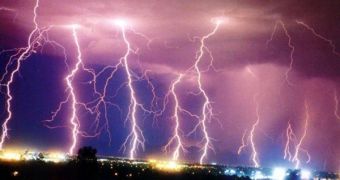A new breakthrough in the dynamics of lightning has recently revealed the source of X-ray light emitted moments before the lightning strikes and could help in the near future advance the methods used to predict the moment and location where these phenomena occur.
"From a practical point of view, if we are going to ever be able to predict when and where lightning will strike, we need to first understand how lightning moves from one place to the other. At present, we do not have a good handle on this. X-rays are giving us a close-up view of what is happening inside the lightning as it moves," said Joseph Dwyer, professor in the department of physics and space sciences at the Florida Institute of Technology.
Investigations conducted at the University of Florida and the Florida Institute of Technology with the help of electric field and X-ray detectors at the lightning research facility in North Florida showed for the first time that as the discharge starts moving downwards from the clouds in 9 to 49 meter long stages, X-ray emissions are generated ahead each stage several couple of millionths of a second before the discharge completes it.
"Nobody understands how lightning makes X-rays. Despite reaching temperatures five times hotter than the surface of the sun, the temperature of lightning is still thousands of times too cold to account for the X-rays observed. It's obviously happening. And we have put limits on how it's happening and where it's happening," said Martin Uman, professor of electrical and computer engineering.
The existence of X-ray emissions in lightning has been theorized ever since the mid 1920s, albeit it wasn't until the early 2000s that researchers with the University of Florida and with the Florida Institute of Technology have been able to confirm the old prediction. Since then, multiple confirmations of the phenomenon came from research institutes from all over the world.
The initial discovery in 2001 was made by measuring the effects generated by natural lightning, while the most recent study carried out at the International Center for Lightning Research Laboratory examined lightning strikes triggered with the help of wire-trailing rockets. Both techniques indicate that X-rays are emitted at the beginning of each step ahead of the discharge.
"We could see when the electric field arrived at the sequence of stations, and it was the same with the X-rays. We then went back and calculated what the source location was for the field and the X-ray," Uman said.
"A spark that begins inside a thunderstorm somehow manages to travel many miles to the ground, where it can hurt people and damage property. Now, for the first time, we can actually detect lightning moving toward the ground using X-rays. So just as medical X-rays provide doctors with a clearer view inside patients, X-rays allow us to probe parts of the lightning that are otherwise very difficult to measure," Dwyer added.

 14 DAY TRIAL //
14 DAY TRIAL //